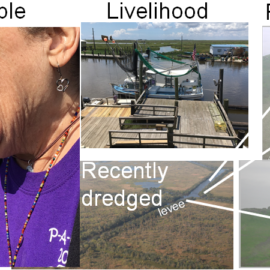
Once upon a day, when the native tribes and others traveled the Tangipohoa river is was clean, pristine and odorless. Not today.
There was something pristine about the Natalbany and Yellow Water rivers when Spanish colonists, the Choctaw Nation and Confederate soldiers traveled their waters to transport goods and supplies through what would later become Tangipahoa Parish. These days, there is so much fecal contamination in both that the rivers are off-limits for swimming. No one knows where the waste is coming from, but the U.S. Environmental Protection Agency has asked two LSU researchers to find out. “I’ll be able to say if it’s human, pigs, deer or cows,” said Aaron Bivins, an assistant professor of civil and environmental engineering. “By taking different measurements, we’ll be able to tell community leaders if half of the contamination is coming from human sewage and other percentages from animals.”
theadvocate.com
The river has been impaired since 2002 and it has marinas and goes through Hammond so there is an idea of what is polluting it.
The Louisiana Department of Environmental Quality says the rivers have been impaired due to fecal coliform and other contaminants since 2002, and has its own ideas about potential sources. Marinas and residences line the deeper and wider Natalbany, while the shallower Yellow Water runs through populated areas just west of the city of Hammond. Bivins and his colleague Aaron Snow will use a $497,000 grant track the sources of contamination and suggest ways to address it. The pair will use a newer technology called molecular source tracking to measure genetic material of feces at different points on the river. This will allow them to find out what species the feces is coming from, and where on the river the contamination is strongest. The Louisiana Department of Environmental Quality can then use that research to form plans for improvement. Bivins said many residents in the area use aerated treatment units for waste, or on-site miniature wastewater treatment systems for their property. Aerated wastewater treatment systems require electricity to operate, but are cheaper to install and require less maintenance than septic tanks. More importantly, though, is that aerated systems can be stored above ground, which is often the only option for these properties as they lack the soil conditions for a below-ground septic tank. If regular maintenance isn’t being done on these systems, then waste can quickly become a contamination source. While they aren’t sure where the contamination is coming from in the Natalbany River, the LDEQ suspects this to be the source of contamination for the shallower Yellow Water River.
The use of the waterway has changed from industry, carrying goods, to recreation.
Southeastern Louisiana University history professor Sam Hyde, an expert on the area who owns property along the Natalbany, said records show the rivers was used to transport goods from well before Tangipahoa Parish was created in 1869. In modern times, the Natalbany has been used for recreational boating and fishing. He said his son went out water-skiing on the river just a few days ago. “Virtually everything you can think of a Louisiana waterway being used for, it has been,” Hyde said. “I’m very concerned… This is the first I’ve heard about [the contamination.]” Both rivers are considered unsafe for swimming by the LDEQ because “fecal coliform criteria are exceeded in more than 25% of samples taken for assessment.”
Once the sources of the pollution have been identified there will be a public education program coupled with the Pontchartrain Conservancy.
Once they identify the source of the contamination, Bivins and Snow will work with the New Orleans-based Pontchartrain Conservancy to educate the public on how to improve local water quality and prevent unpermitted waste disposal. Bivins said research rarely involves community engagement, making this project particularly exciting for him. “As an academic researcher, sometimes we do a lot of science that doesn’t necessarily make an immediate difference in the community,” Bivins said. “For me, my interest is in environmental microbiology and public health, so the opportunity to do something so near to decision-making and to actually make real improvements in the community is what I’m most excited about.” Previous research on the area by the conservancy shows that while over 500 discharges in rivers around Hammond were permitted, at least 80 were not.
One of the other projects will be to help the consumer with individual treatment packages.
Snow will also attempt to develop a newer, smaller wastewater disinfection unit for individual properties using UV-LED technology. This device would use ultraviolet rays in addition to chlorine to disinfect waste at a lower cost than current available systems, though it likely won’t develop for a few more years. Bivins said he and his crew will explore the proposed sampling sites next week and will begin actual fieldwork in August, once the fall semester commences. Bivins hopes his and Snow’s research can be replicated in other bodies of water suffering fecal contamination in the future. “It’s going to be great for everyone, not only in the U.S., but also in developing countries where a small-scale treatment system could actually be a big improvement,” Snow said. “It’s pretty rare for academics to have this opportunity, so we’re both very excited about this project.”
I am glad that this project is working to help individuals both here and in other countries.



